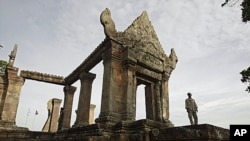[Editor’s Note: John Burgess first visited Cambodia in 1969, and left fascinated by the ancient Angkor civilization. A former Washing Post foreign correspondent with deep experience in Southeast Asia, his first book on Cambodia was “Stories in Stones: The Sdok Kok Thom Inscription and the Enigma of Khmer History.” His most recent, “The Stairway Guide’s Daughter,” is a work of fiction set in the 12th century at the clifftop temple of Preah Vihear, famous for its 2,400-step stairway. Recently, Burgess sat down with VOA Khmer’s Manilene Ek in Washington, D.C., to discuss his latest work and the inspirations behind it.]
This is not your first book, but rather it’s your 4th book that deals with Cambodia and its famous temples such Angkor Wat, Sadok Kok Tom, and Preah Vihear temple. Why are you fascinated with the country’s archaeology and its history?
I had a good fortune that in 1969 when I was still a teenager and in a diplomatic family living in Bangkok—my mother took me to Angkor Wat. We spent two, maybe three days, there. It was a golden age of peacefulness and also very few people at the time. I will always remember getting [up] early one morning and walking across to Angkor Wat and having the place for almost entirely to myself. And having a big (almost) life-changing impression made on me. I was walking among one of the most incredible things ever built in all of human history. Both on a scale of size, religious symbolism, spirituality and actual construction and engineering skills. Even though I was very young, that experience really stayed with me and later in life. I started going back and really educating myself about the place. I’m just blown away by it. I think many people who go and see it feel the same way.
When did you visit Preah Vihear?
I first visited Preah Vihear in 1974 during the Cambodian civil war. At that time, Preah Vihear was a military position of the Lon Nol government in Phnom Penh. You could cross over from Thailand and visit for a few hours. Preah Vihear has all of the glories of the ancient Khmer architecture. It also has an incredible physical setting. It’s at the top of a 500-meter tall cliff and you can see for many kilometers around. When you stand on the edge of the cliff and when the wind is blowing your hair, you have no troubles understanding how this was seen as a holy place.
You climbed the Preah Vihear temple. How many steps are there and how long did it take for you to get to the top?
This was many years later after the war was over. In 2013, I think. There are approximately 2,400 steps. There’s an ancient stone stairway that ran from the plain below Preah Vihear all the way up the side of the mountain. That stairway is still in places. It’s eroded away in other places. The Cambodian government has now built a wooden stairway that runs alongside it. You can walk as far as you can on the ancient stone steps and then switch to the wooden stairway. I think it took us about two and a half hours to get to the top.
Why are all of your books about Cambodia?
I was never tired of learning about the place, visiting the place, and trying to make sense of it. I am not an academic. I can’t read Khmer inscription but I see it as my role as a writer to maybe decipher a lot of technical academic writing that has been on the subject and make it available to a broader audience. But every time I go to Angkor or any of the temple from that period, I just have a feeling of disbelief that such things are possible and were built with the technology that was available in the 12th century. The West Baray, for instance, in Angkor— has a holy water reservoir that runs approximately eight kilometers long and three kilometers wide with an island in the middle of the temple—all built through the power of human arms and shoulders and probably some elephants as well.
Let’s talk about your new book, “The Stairway Guide’s Daughter”. It takes place in the golden age of Cambodia’s Angkor civilization and is set at Preah Vihear. How did this story come about?
My first novel about the Angkor civilization is called “The Woman of Angkor”. It’s set largely in the royal court of Angkor and the characters are prominent people. I wanted to try writing something that would have a main character who was not prominent. Who was not educated, and who was overlooked by her own society. Who, through, a forest of personality and determination has made a really big impact on the people around her.
I have had in mind for some time a novel set at Preah Vihear. Just because it’s a wonderful setting. And when you go there, you start wondering who are these people who built this place? And inhabited the place and kept it running years after years. Actually, I found out about that stairway before I have seen it. I read about it and most people who go there are not even aware that it exists. The idea came that just as people who go up to the mountain now with the motorbike driver or a pickup truck driver, they probably went up the mountain in the old days in the company of a guide because it was a physically strenuous and potentially dangerous. You could fall very easily on the steps in the steep sections.
It was a place of unusual and unknown spirits. You might need some kind of guide to help you make a good impression on those spirits and not offend them as you path up the mountain. So, the idea of a family having a hereditary job to guide people up the stairway came into my mind. Since I wanted the main character to be a “lesser” person, I thought “let’s make the main character the daughter rather the stairway guide himself—the head of the family.”
Jorani, your main character, is portrayed as a strong Cambodian woman, but is conflicted between faith, love, and loyalty. Why were these her struggles?
She’s very close to her father. Over the course of the story, Jorani gets drawn into a conflict. A theological conflict over succession at the temple. Who is going to be the next abbot? It starts off as something that is sort of a civilized Eden. Then emotion arises and the temple community becomes divided as to which side they are going to. It happens that Jorani ends up on one side and her father ends up on another side. She is torn between loyalty and love for her father and what she feels is her obligation. It’s both because of spiritual reasons and for her current employer, the abbot of the monastery. At first, she doesn’t have any idea what this conflict is about. She is young and uneducated. She gradually comes to understand that this is both a theological conflict and also a conflict over the question, in the here and now. Who is going to get this wonderful post as abbot of the temple?
You write about interesting characters who grow and change over time in a historical fiction setting. Why is this?
I feel that we’re all different individuals. We’re all different people as we progress through life. We have one personality and one set of expectations and ambitions when we were young and we have another set when we are older. In terms of storytelling, it’s great to explain how did this person get from [point] A to B?
Jorani starts off as young and naïve. Later on, she is in the middle of a struggle and becoming somebody that the people rely on. She discovers that she has within herself capabilities and courage that she didn’t know she had and probably would not have come out had she not been in the situation to begin with.
In my first novel, you also have a great change. The main character in the Woman of Angkor is born in very humble condition and through a lot of different events—which she has no control of—she is promoted and becomes a very wealthy and much sought after spiritual guide. She is propelled into that position but she has enough humanity and personality that she really doesn’t like this high flying life and dream of going back to be a simple village person later in life.
For those people who have never been to Preah Vihear, what would you tell them about this UNESCO World Heritage Site?
It’s a very unusual temple in that it was built and modified by many kings rather than having one particular sponsor. It has a complete design from what you see in Angkor. Most of those temples are rectangular. This one is a raid along the avenue and it’s actually five different temples along an avenue that runs almost a full kilometer. The amazing thing about this is the setting in the avenue that runs up a gentle slope. The other side of that mountain is a sheer drop of about 500 meters. Now, in Hinduism, mountains were very important things spiritually and most of the temples of Angkor are a symbolic depiction of mountains. Mount Meru [is] the center of the universe. Here, we have a temple that is a mountain on the top of a mountain. A natural mountain and then a metaphorical mountain. And a temple on top of that. It brings the symbolism of this place to a whole nother level.
Thailand and Cambodia have long had a feud to who owns the temple. In 1962, the world court ruled that it belongs to Cambodia. In 2008 and in 2011, there were actually brief border wars at the temple over this issue, not of the temple but the land around the temple. During the Cambodian civil war, Preah Vihear was always a military redoubt of one faction or another.
If you go there, you can do it as a long day trip from Siem Reap. It’s about a 3-hour drive. Most people go up the mountain on a motorbike or a pickup truck and that ride is kind of scary. It’s a very steep ride, very steep road winding back, and you have to have full trust in your driver. But it only takes about 15 minutes. Then, you get to the top. Usually, there aren’t that many visitors there and you can wander around the place and imagine what it was like in the days when the hallways were full of golden chalices, bright drapes, and shrines. Then you get to the very top and you have this spectacular physical view. You can see probably 100 kilometers on a clear day from up there. On some days in the rainy season, the clouds go right through the temple and it gives you another sort of moving effect of you actually being in the cloud.










